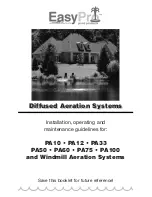
4
valve button overrides automatic operation to validate priming or to determine diaphragm
integrity.
The
HPV
automatically maintains the required hydraulic oil volume by replacing any oil lost past
the piston or through the PTP valve.
The
HBV
protects the pump from over-pressurizing by relieving any excess pressure in the
pump’s hydraulic system.
2.2.3 Control Assembly
Figure 5
PULSAR pumps incorporate a lost motion style of stroke length adjustment to limit piston travel
during the suction portion of each stroke. The stroke length setting is denoted by a (0 - 100)
scale located on the top of the unit.
Stroke is changed by depressing and turning the hand knob. This turns a screw which locates a
slider cam to position the follower pin as to limit the rearward travel of the piston. If the control
cover is removed and replaced, the bolts should be tightened to 20-24 In-lbs. (225
– 270 N-cm).
PULSAR pumps may also be equipped with the Pulsafeeder DLC or DLCM electronic stroke
length controllers. These allow for local and/or remote automatic control over stroke length
(DLC) or stroke length and motor speed (DLCM). Pumps equipped with the DLC or DLCM
controllers are provided with separate instructions for the controller. Refer to the appropriate
Installation, Operation and Maintenance Manual (IOM-CTL-DLC-2005 or IOM-CTL-DLCM-
2004).
Some PULSAR pumps may also be equipped with the MPC control which allows for pump flow
control over a wide range via a specially designed variable speed drive. The MPC Installation,
Operation and Maintenance manual IOM-MPC-0104 covers information specific to this type of
control and should be consulted prior to operating the pump or the controller.
Summary of Contents for PULSAR 25HJ
Page 53: ...47...










































